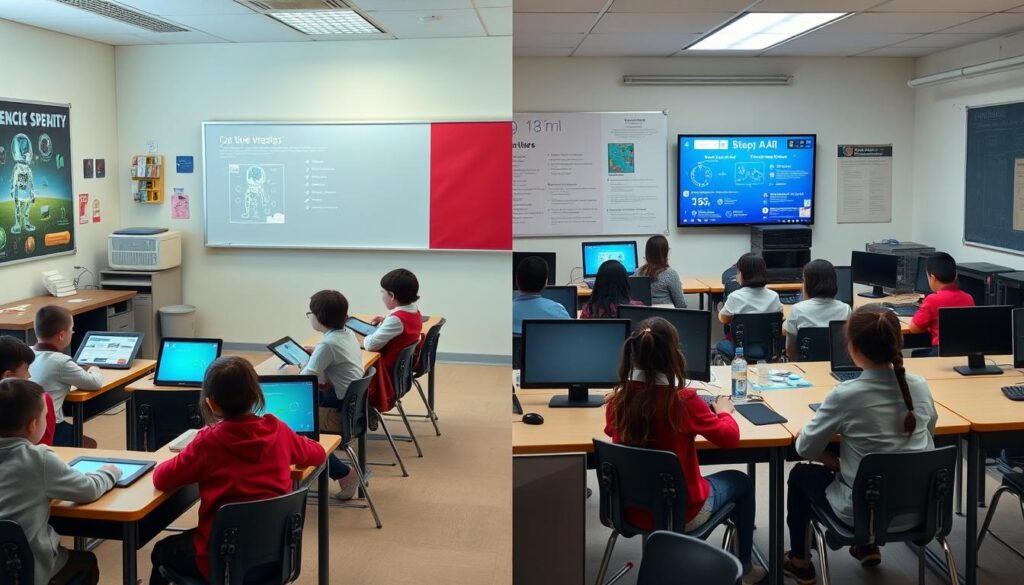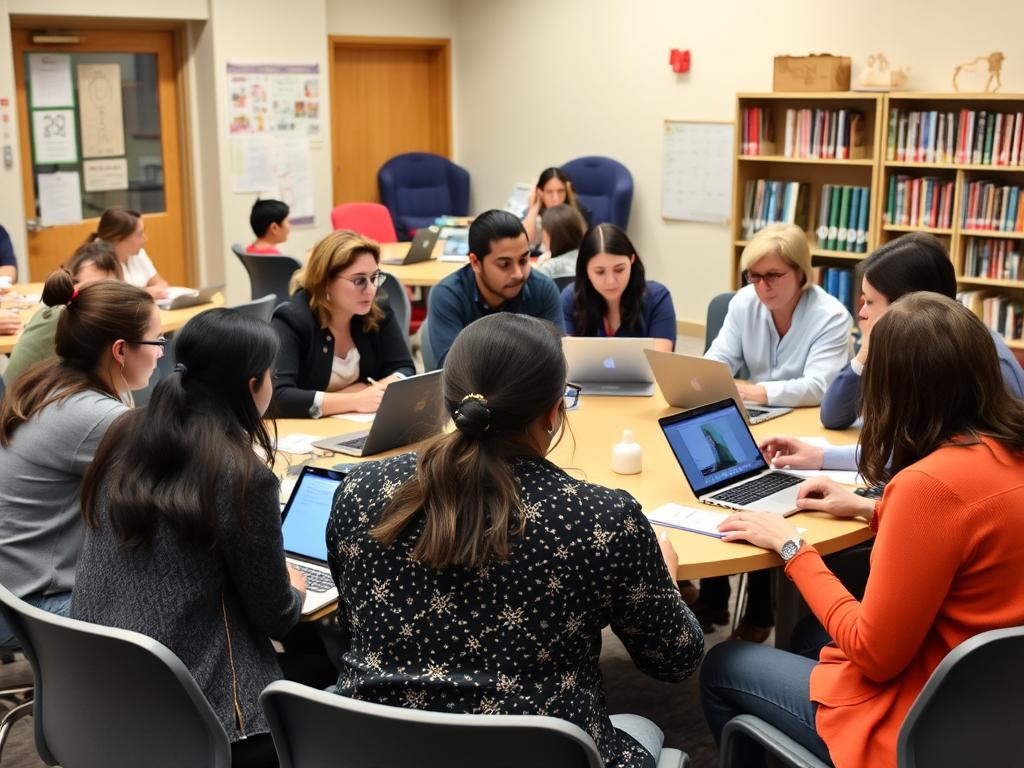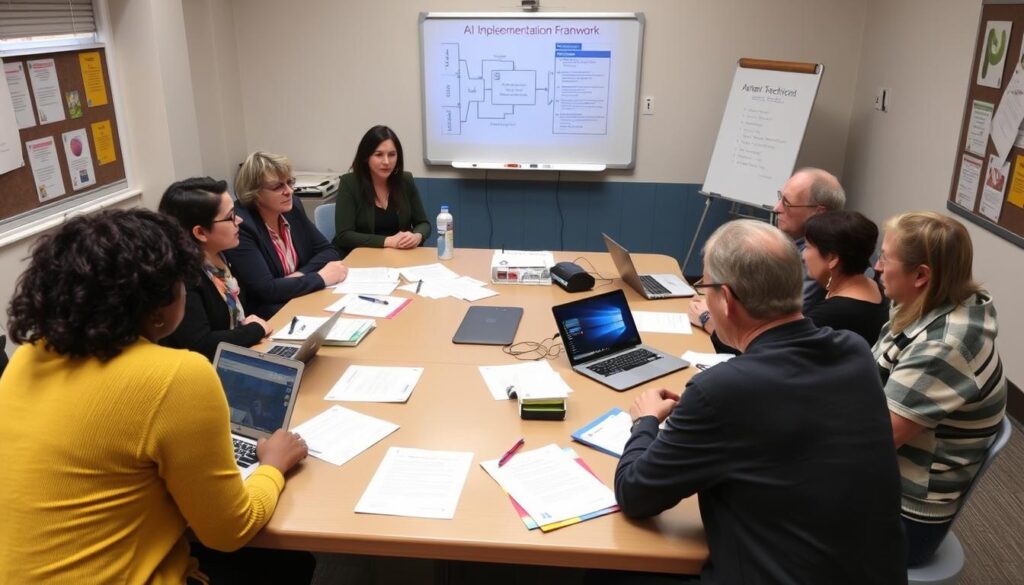Artificial intelligence is rapidly transforming education, offering new possibilities for personalized learning while raising important questions about implementation. As AI tools become more accessible, educators and parents are navigating the benefits and challenges of integrating this technology into classroom settings. This balanced exploration examines how AI is reshaping educational experiences through the perspectives of those on the front lines—teachers implementing these tools and parents observing the impacts on their children’s learning journeys.
Key Benefits of AI in the Classroom
The integration of artificial intelligence in educational settings offers several advantages that can enhance the learning experience and support both students and teachers. Here are five significant benefits that educators and parents have identified:
1. Personalized Learning Experiences
AI technology can analyze individual student performance data to create customized learning paths that address specific strengths and weaknesses. This level of personalization was previously impossible for teachers managing classrooms of 20-30 students.
“Before implementing AI-assisted math programs, I struggled to provide individualized attention to all 28 of my fifth-graders. Now, the adaptive software adjusts difficulty levels in real-time while I focus on supporting students who need additional guidance. I’ve seen remarkable progress, especially among students who were falling behind.”
These personalized learning systems continuously adapt to student progress, providing additional practice in challenging areas while accelerating through mastered concepts—creating an educational experience tailored to each learner’s unique needs.
2. Automated Grading and Feedback
AI tools can significantly reduce the administrative burden on teachers by automating routine grading tasks and providing immediate feedback to students. This efficiency allows educators to focus more time on high-value instructional activities.
- Immediate assessment of multiple-choice and fill-in-the-blank questions
- Basic writing evaluation for grammar, structure, and vocabulary
- Detailed analytics on common student misconceptions
- Time savings of 5-10 hours weekly for many teachers
With AI handling routine assessments, teachers can dedicate more energy to developing engaging lessons, providing targeted interventions, and building meaningful relationships with students.
3. Enhanced Accessibility for Diverse Learners
AI-powered tools are making education more accessible to students with diverse learning needs, including those with disabilities or language barriers.
“My son has dyslexia and always struggled with reading assignments. Since his school introduced AI text-to-speech and speech-to-text tools, his confidence has soared. He can now demonstrate his knowledge without being limited by his reading challenges. The technology has leveled the playing field and shown him that his learning difference doesn’t define his intelligence.”
These accessibility tools include real-time captioning for deaf or hard-of-hearing students, language translation for English language learners, and adaptive interfaces for students with physical disabilities—making quality education more equitable.
4. Data-Driven Insights for Educators
AI systems excel at analyzing large datasets to identify patterns that might escape human observation. In educational contexts, this capability provides teachers with valuable insights into student performance and engagement.

These analytical tools can alert teachers to students who may be at risk of falling behind, recommend specific interventions based on learning patterns, and even predict which instructional approaches might be most effective for different groups of students.
5. Preparation for an AI-Integrated Future
As artificial intelligence becomes increasingly prevalent across industries, students who gain familiarity with these technologies in educational settings will be better prepared for future careers.
“I initially had reservations about AI in my daughter’s high school, but I’ve come to see it as essential preparation for her future. The workforce she’ll enter will be fundamentally different from mine. By learning to collaborate with AI tools now—understanding both their capabilities and limitations—she’s developing critical skills that will serve her regardless of which career path she chooses.”
Students who learn to work alongside AI develop important skills in digital literacy, critical evaluation of machine-generated content, and ethical considerations surrounding technology—competencies that will be increasingly valuable in their personal and professional lives.
Major Concerns About AI in Educational Settings
While artificial intelligence offers significant benefits to education, its implementation raises important concerns that must be thoughtfully addressed. Teachers and parents have identified several key challenges that require careful consideration:

1. Privacy and Data Security Risks
AI educational tools collect substantial amounts of student data to function effectively, raising legitimate concerns about privacy protection and data security.
- Collection of sensitive personal information and learning behaviors
- Potential for data breaches exposing student information
- Questions about long-term data storage and ownership
- Compliance challenges with educational privacy regulations
“As a computer science teacher, I understand the technical benefits of AI, but I’m deeply concerned about data collection practices. Many educational AI platforms gather extensive information about our students—from academic performance to behavioral patterns—with unclear policies about how that data is used, shared, or protected. We need much stronger transparency and safeguards before widespread adoption.”
Schools must implement robust data governance policies and carefully evaluate vendor privacy practices to protect student information while still benefiting from AI capabilities.
2. Potential for Reduced Human Interaction
The increasing reliance on AI-powered learning systems raises concerns about diminishing human connections that are fundamental to quality education.
Research consistently shows that strong teacher-student relationships are among the most significant factors in educational success. While AI can enhance instruction, it cannot replace the empathy, inspiration, and mentorship that skilled educators provide.

Finding the right balance between technological efficiency and human connection represents one of the most significant challenges in AI implementation.
3. Bias and Fairness Concerns
AI systems reflect the data used to train them, potentially perpetuating or amplifying existing biases in educational materials and assessment.
- Algorithmic bias affecting content recommendations
- Potential discrimination in automated assessment
- Unequal performance across different demographic groups
- Risk of reinforcing stereotypes in educational content
Educators must critically evaluate AI tools for potential bias and ensure they promote equitable outcomes for all students, regardless of background or learning style.
4. Risk of Overreliance and Diminished Skills
There are legitimate concerns that excessive dependence on AI tools could undermine the development of fundamental skills and critical thinking abilities.
“I’ve noticed a troubling pattern in my English classes since we started using AI writing assistants. While these tools help students produce more polished work, I’m seeing a decline in their ability to develop original ideas and construct arguments independently. I worry we’re creating a generation that can edit AI-generated content but struggles to produce their own thoughtful writing from scratch.”
Finding the appropriate balance—where AI supports skill development rather than replacing it—remains a significant challenge for educators implementing these technologies.
5. Digital Divide and Equity Issues
The benefits of AI in education are not equally accessible to all students, potentially widening existing achievement gaps between well-resourced and under-resourced schools.

Addressing these equity concerns requires intentional policies to ensure that advanced educational technologies benefit all students, not just those in privileged circumstances.
Real-World AI Tools Currently Used in Schools
To better understand the practical applications of artificial intelligence in education, let’s examine some widely implemented AI tools that are already transforming classroom experiences:
1. DreamBox Learning
DreamBox is an adaptive mathematics platform that continuously adjusts to student performance, providing personalized learning paths for K-8 students.

- Uses predictive analytics to determine optimal learning sequences
- Provides over 2,000 lessons with multiple solution paths
- Adjusts difficulty based on student interactions and solution strategies
- Generates detailed progress reports for teachers and parents
Research conducted by Harvard University found that students who used DreamBox for just one hour per week showed significant improvements in mathematics achievement scores.
2. Turnitin’s Revision Assistant
This AI-powered writing tool provides students with immediate, specific feedback on their writing while helping teachers identify potential plagiarism.

- Analyzes writing across multiple dimensions (organization, evidence, language)
- Provides specific, actionable suggestions rather than just identifying errors
- Allows students to request feedback throughout the writing process
- Helps teachers track revision history and writing development
This tool exemplifies how AI can support the development of complex skills while still keeping educators central to the learning process.
3. Century Tech
Century Tech is a comprehensive learning platform that uses AI to create personalized learning pathways across multiple subjects.

- Creates “micro-lessons” tailored to individual learning needs
- Identifies knowledge gaps and automatically assigns remedial content
- Provides teachers with insights about learning patterns and recommended interventions
- Reduces teacher workload by automating content selection and basic assessment
Schools implementing Century Tech have reported significant time savings for teachers while also seeing improvements in student engagement and achievement.
Teacher Perspectives on AI Implementation
Educators on the front lines of AI implementation offer valuable insights into the practical realities of integrating these technologies into daily classroom activities:

“When we first introduced AI writing tools, I was skeptical. I worried they would just do the work for students. But I’ve found that with proper guidance, these tools actually enhance the writing process. My students use AI for brainstorming and basic editing, which allows our class discussions to focus on higher-level concepts like argument development and stylistic choices. The key has been establishing clear guidelines—AI as a collaborator, not a replacement for student thinking.”
Many educators emphasize the importance of thoughtful implementation strategies that clearly define the appropriate role of AI in the learning process. Without such boundaries, there’s a risk that students may use these tools to circumvent important learning experiences.
“The adaptive math program we use has transformed how I approach differentiation. Before, I struggled to challenge advanced students while supporting those who needed extra help. Now, the AI handles much of that differentiation automatically, allowing me to focus on the human elements of teaching—building relationships, fostering collaboration, and developing students’ mathematical reasoning. It’s not about replacing teaching; it’s about enhancing what’s possible in a diverse classroom.”
Teachers consistently report that the most successful AI implementations are those that augment rather than replace their expertise, allowing them to focus on the aspects of education that require human judgment, creativity, and emotional intelligence.
“The biggest challenge I’ve faced with AI in my classroom isn’t technical—it’s philosophical. We need ongoing conversations about the ethical dimensions of these tools. When is AI assistance appropriate? When does it undermine learning? How do we ensure equitable access? These aren’t questions with simple answers, and they require continuous reflection as the technology evolves. Teacher voice must be central to these discussions.”
This perspective highlights the importance of including educators in policy decisions about AI implementation, as they bring crucial practical insights about the classroom implications of these technologies.
Parent Perspectives on AI in Education
Parents offer unique perspectives on how AI is affecting their children’s educational experiences and development:

“As a parent of a child with ADHD, I’ve seen remarkable benefits from the AI learning platform his school implemented. The program adapts to his attention span, breaking lessons into manageable chunks and providing immediate feedback that keeps him engaged. His frustration has decreased significantly, and for the first time, he’s experiencing consistent academic success. However, I still worry about data privacy—who has access to this detailed information about his learning challenges?”
Many parents of children with learning differences report that AI tools provide valuable support, though these benefits often come with concerns about data collection and potential labeling of students.
“I have mixed feelings about the AI writing assistant my daughter uses for her essays. On one hand, it’s improved her confidence by helping with grammar and structure. On the other hand, I wonder if she’s developing the resilience to work through writing challenges independently. I’ve started asking her to show me her drafts before using the AI tool, so I can see her original thinking. Finding that balance between support and independence seems crucial.”
This perspective reflects a common parental concern about finding the appropriate balance between technological assistance and the development of independent skills and resilience.
Parents consistently emphasize the importance of transparency from schools about how AI tools are being used, what data is being collected, and how these technologies complement rather than replace quality teaching.
Recommendations for Effective and Ethical AI Integration
Based on the experiences of educators and parents, here are actionable recommendations for implementing AI in educational settings while addressing key concerns:

1. Develop Clear AI Usage Policies
- Create explicit guidelines for appropriate AI use in assignments and assessments
- Establish transparency requirements for when AI tools are used in student work
- Define boundaries between acceptable assistance and academic dishonesty
- Involve teachers, students, and parents in policy development
2. Prioritize Data Privacy and Security
- Conduct thorough privacy impact assessments before adopting new AI tools
- Select vendors with strong data protection practices and transparent policies
- Limit data collection to what’s necessary for educational purposes
- Ensure compliance with relevant educational privacy regulations
- Communicate clearly with parents about data practices
3. Invest in Teacher Professional Development
- Provide comprehensive training on effective AI integration strategies
- Support teachers in developing AI literacy to evaluate tools critically
- Create opportunities for educators to share best practices and challenges
- Ensure teachers understand how to identify and address potential biases
4. Maintain Focus on Core Skills Development
- Use AI as a scaffold that supports rather than replaces skill building
- Design assignments that require original thinking beyond AI capabilities
- Teach students to critically evaluate AI-generated content
- Balance technology use with traditional learning approaches
5. Address Equity and Access Issues
- Develop strategies to ensure equitable access to AI educational tools
- Consider home technology access when designing assignments
- Provide alternative options for students without reliable technology access
- Monitor outcomes across demographic groups to identify and address disparities
6. Foster Ongoing Dialogue and Adaptation
- Create regular forums for stakeholder feedback on AI implementation
- Stay informed about emerging research and best practices
- Be willing to adjust approaches based on observed outcomes
- Maintain transparency about successes, challenges, and changes in approach

By implementing these recommendations, schools can harness the benefits of AI while thoughtfully addressing the legitimate concerns raised by educators and parents.
Conclusion: Balancing Innovation and Responsibility
Artificial intelligence in the classroom represents both tremendous opportunity and significant responsibility for educational stakeholders. The perspectives of teachers and parents highlight that AI is neither a panacea nor a threat—it’s a powerful tool whose impact depends entirely on how thoughtfully it is implemented.
The most successful approaches to AI integration maintain a clear focus on enhancing rather than replacing human elements of education. They leverage technology to handle routine tasks while creating more space for the creative, interpersonal, and critical thinking aspects of learning that remain essentially human.
As AI continues to evolve, ongoing dialogue between educators, parents, students, and technology developers will be essential. By maintaining this conversation and approaching implementation with both optimism and critical awareness, schools can harness AI’s potential while safeguarding the core values and relationships that have always been at the heart of quality education.
Get Your Free AI Implementation Guide
Download our comprehensive guide for educators and parents on implementing AI in educational settings ethically and effectively. Includes practical worksheets, policy templates, and student discussion frameworks.
Frequently Asked Questions
How can teachers ensure AI tools enhance rather than replace critical thinking?
Teachers should design assignments that use AI as a starting point rather than an end point. For example, have students analyze and critique AI-generated content, use AI for initial research but require original synthesis, or have students explain the reasoning behind AI-suggested solutions. The key is establishing clear guidelines about when and how AI should be used, while ensuring that higher-order thinking skills remain central to assessment.
What should parents ask schools about AI implementation?
Parents should inquire about data privacy policies (what information is collected and how it’s protected), ask how the school balances AI use with traditional skill development, understand how teachers are being trained to implement these tools effectively, and learn about equity measures to ensure all students benefit. Parents might also ask about opportunities for their input in developing AI policies and guidelines.
How can schools address the digital divide when implementing AI tools?
Schools can implement device lending programs, create extended access to computer labs before and after school hours, partner with community organizations to provide internet access, ensure all AI tools work on multiple device types including smartphones, and always provide non-digital alternatives for assignments. Additionally, schools should monitor usage patterns and outcomes across demographic groups to identify and address access disparities.







